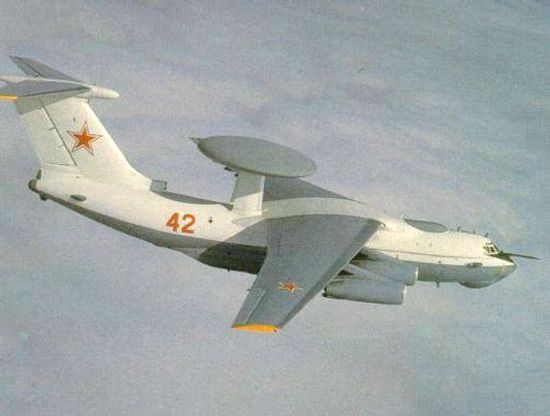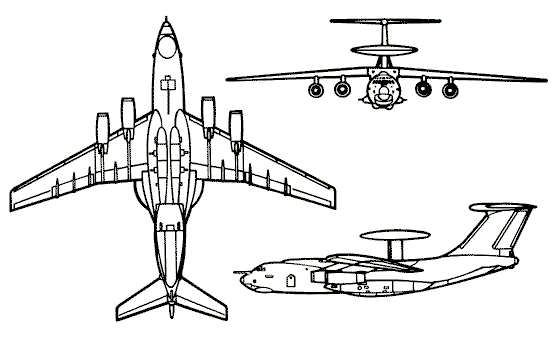|
||||||||||
|
|
||||||||||
|
||||||||||
|
|
||||||||||
 - -
 - -
|
|

|
Ilyushin / Beriev A-50 ASCC codename: Mainstay Airborne Early Warning And Control Aircraft |
|
DESCRIPTION:
The A-50 'Mainstay' was developed to replace the aging Tu-126 'Moss' airborne early warning and control aircraft. The A-50 is based on the Ilyushin Il-76 transport aircraft, but the majority of the modifications have been performed by Beriev. In comparison to the original airframe, the A-50 incorporates a lengthened fuselage with space for display consoles and communications sytems for the 10 mission specialists. Similar to western designs performing the same mission, the most prominent feature of the A-50 is its large rotating radome mounted above the fuselage. Installed in the forward portion of the radome is the antenna for the surveillance radar while the after section houses various data-link systems that allow the A-50 to vector up to 10 or 12 interceptors at once. Mounted further forward on the fuselage is a canoe fairing that houses a satellite communications antenna. The A-50 is also equipped with twin flare pods to defend against heat-seeking missiles, wingtip electronic countermeasures pods, an inflight-refueling probe in the nose, and a radar warning receiver. Tasked with detecting incoming cruise missiles as well as to provide airborne command to friendly fighters, the A-50 can operate over both land and water and is typically operated along the Russian coasts. An improved model equipped with a much more powerful radar was unveiled in 1995, and some 25 to 40 total aircraft are believed to have been built by the late 1990s. While most remain in Russian service, pairs of aircraft have also been leased to both India and China. China hoped to have its aircraft upgraded with the Israeli Phalcon radar system, but the deal fell through due to political pressure from the US and technical difficulties mounting the Phalcon system on a rotating radome. China responded to these difficulties by developing its own early warning aircraft based on the Il-76 known as the KJ-2000. Iraq also converted three former civil Il-76 aircraft with radar equipment similar to that aboard the A-50. One was destroyed and two were interred by Iran during the 1991 Gulf War, leaving Iraq with none. Only one of Iranian planes was operational but was lost following a midair collision in 2009.
Last modified 27 September 2009
|
|
| HISTORY: | |
| First Flight | 19 December 1978 |
|
Service Entry
|
1984
|
| CREW: |
four flight crew: pilot, co-pilot, navigator, flight engineer eleven systems operators: commander, engineer, three detection operators, four control operators, two communications operators |
|
ESTIMATED COST:
|
unknown
|
| AIRFOIL SECTIONS: | |
| Wing Root | TsAGI P-151 (13%) |
|
Wing Tip
|
TsAGI P-151 (10%)
|
| DIMENSIONS: | |
| Length | 182.83 ft (46.59 m) |
| Wingspan | 165.67 ft (50.54 m) |
| Height | 48.42 ft (14.76 m) |
| Wing Area | 3,229.28 ft² (300.0 m²) |
|
Canard Area
|
not applicable
|
| WEIGHTS: | |
| Empty | unknown |
| Normal Takeoff | unknown |
| Max Takeoff | 418,880 lb (190,000 kg) |
| Fuel Capacity | 142,905 lb (64,820 kg) |
|
Max Payload
|
unknown
|
| PROPULSION: | |
| Powerplant | four Soloview D-30KP turbofans |
| Thrust |
105,820 lb (470.4 kN)
|
| PERFORMANCE: | |
| Max Level Speed |
at altitude: 530 mph (850 km/h) at sea level: unknown |
| Initial Climb Rate | unknown |
| Service Ceiling | 33,435 ft (10,200 m) |
| Range | 3,940 nm (7,300 km) |
| Endurance | 7 hr 42 min |
| g-Limits |
+2
|
| ARMAMENT: | |
| Gun | provision for two 23-mm cannons in a tail turret |
| Stations | 2 wingtip hardpoints |
| Air-to-Air Missile | none |
| Air-to-Surface Missile | none |
| Bomb | none |
| Other |
ECM pods, self-defense flares
|
| KNOWN VARIANTS: | |
| A-50 | Production airborne early warning model based on the Il-76 airframe but equipped with a large rotating radome to track 50 to 60 targets and guide 10 to 12 interceptor aircraft simultaneously |
| A-50M | Updated model with a new radar system and more powerful computer |
| A-50U | Improved AEW model with a new radar, increased maximum takeoff weight, and increased patrol duration |
| A-50I | Chinese model intended to integrate the Israeli Phalcon radar system onto the A-50; one prototype built but the program was cancelled |
| KJ-2000 'Mainring' | Chinese variant of the A-50 equipped with an active electronically-steered phased array radar; at least four modified from the A-50I and Il-76MD transports |
| Il-976 | Civilian derivative of the A-50 serving as range control and data recording aircraft for flight testing, based on the Il-76 and equipped with a similar rotodome as the A-50 but retains the glass nose of the Il-76 and lacks many of the A-50's electronic fairings, antennas, and inflight-refueling probe; 5 converted |
| Baghdad 1 | Iraqi Il-76MD airframe modified as an aerial radar platform through the addition of a Thomson-CSF Tigre surveillance radar mounted behind a blister radome in place of the aft clamshell doors, radar system crew included four operators and allowed monitoring a 180° sweep out to 190 nm (350 km); 1 converted but deemed unsuccessful due to unspecified problems |
| Adnan |
Iraqi Il-76 airframes modified as AEW aircraft by mounting a 29.5 ft (9 m) diameter rotating radome atop
the fuselage; 3 converted but 1 was destroyed during the 1991 Gulf War and the other two fled to Iran
|
|
KNOWN COMBAT RECORD:
|
Iraq - Operation Desert Storm (Iraq, 1991)
|
|
KNOWN OPERATORS:
|
China, Zhongkuo Shenmin Taifang Tsunputai (People's Liberation Army Air Force) India, Bharatiya Vayu Sena (Indian Air Force) Iran (Islamic Republic of Iran Air Force) Iraq, Al Quwwat Al Jawwiya al Iraqiya (Iraqi Air Force) Russia, Voyenno Vozdushniye Sili (Russian Air Force) Union of Soviet Socialist Republics, Voyenno Vozdushniye Sili (Soviet Air Force) |
|
3-VIEW SCHEMATIC:

|
|
SOURCES:
|
|


|
Aircraft | Design | Ask Us | Shop | Search |

|
|
| About Us | Contact Us | Copyright © 1997- | |||
|
|
|||